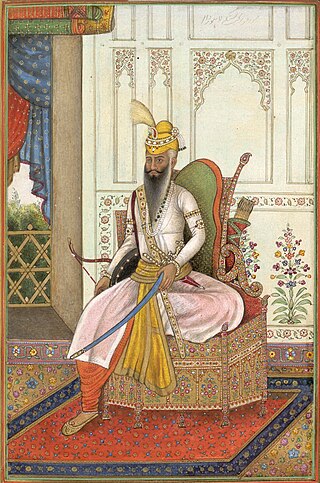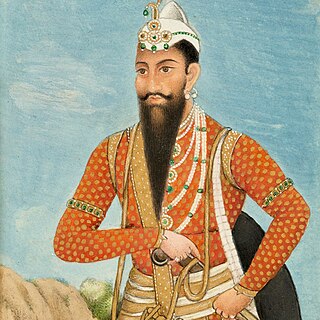
Emir Dost Mohammad Khan Barakzai, nicknamed the Amir-i Kabir, was the founder of the Barakzai dynasty and one of the prominent rulers of Afghanistan during the First Anglo-Afghan War. With the decline of the Durrani dynasty, he became the Emir of Afghanistan in 1826. An ethnic Pashtun, he belonged to the Barakzai tribe. He was the 11th son of Payendah Khan, chief of the Barakzai Pashtuns, who was killed in 1799 by King Zaman Shah Durrani.

Ranjit Singh, popularly known as Sher-e-Punjab or "Lion of Punjab", was the first Maharaja of the Sikh Empire, which ruled the northwest Indian subcontinent in the early half of the 19th century. He survived smallpox in infancy but lost sight in his left eye. He fought his first battle alongside his father at age 10. After his father died around Ranjit's early teenage years, Ranjit subsequently fought several wars to expel the Afghans throughout his teenage years. At the age of 21, he was proclaimed the "Maharaja of Punjab". His empire grew in the Punjab region under his leadership through 1839.

The Sikh Empire was a regional power based in the Punjab region of the Indian subcontinent. It existed from 1799, when Maharaja Ranjit Singh captured Lahore, to 1849, when it was defeated and conquered by the British East India Company in the Second Anglo-Sikh War. It was forged on the foundations of the Khalsa from a collection of autonomous misls. At its peak in the 19th century, the empire extended from Gilgit and Tibet in the north to the deserts of Sindh in the south and from the Khyber Pass in the west to the Sutlej in the east as far as Oudh. It was divided into four provinces: Lahore, which became the Sikh capital; Multan; Peshawar; and Kashmir from 1799 to 1849. Religiously diverse, with an estimated population of 4.5 million in 1831, it was the last major region of the Indian subcontinent to be annexed by the British Empire.

Hari Singh Nalwa was the commander-in-chief of the Sikh Khalsa Fauj, the army of the Sikh Empire. He is known for his role in the conquests of Kasur, Sialkot, Attock, Multan, Kashmir, Peshawar and Jamrud. Hari Singh Nalwa was responsible for expanding the frontier of Sikh Empire to beyond the Indus River right up to the mouth of the Khyber Pass. At the time of his death, Jamrud constituted the western boundary of the Empire.
Alawalpur is a town and a municipal council in Jalandhar district in the state of Punjab, India. Alawalpur is named after Alawal Khan, a Pathan who ruled the area during the time of Maharajah Ranjit Singh. Sardar Himmat Singh Jallewalia, a Bains Jat Sardar, a general in Ranjit Singh's army, later conquered Alawalpur. His descendants still live in a fort located at the center of the city.

Diwan Mokham Chand was one of the chief commanders of the Sikh Empire. He conquered Attock from the Durrani Afghans in 1813 and subdued the Rajputs in the Hills of Himachal and in Jammu at Jasrota, Chamba, and Basroli. He also commanded one of the early Sikh expeditions to conquer Kashmir that ended in failure due to bad weather blocking the passes to the valley. Mokham Chand was born in a Hindu Khatri family origin.

The Battle of Nowshera was fought in Nowshera in March 1823 collectively by the Yusufzai Afghans, supported by the Peshawar sardars, alongside Azim Khan Barakzai, the Afghan governor of Peshawar, where they would face the Sikh armies led by Maharaja Ranjit Singh. Azim Khan was a half-brother of Dost Mohammad Khan, the future ruler of Kabul, and later Afghanistan. The battle was a victory for the Sikhs over Azim Khan's armies, a result which allowed the Sikhs to begin their occupation of the Peshawar Valley.

Kharak Singh was the second Maharaja of the Sikh Empire. He was the eldest son of Maharaja Ranjit Singh, founder of the Sikh Empire and his consort, Maharani Datar Kaur. He succeeded his father on 27 June 1839 and reigned until his dethronement and imprisonment on 8 October 1839. He was succeeded by his only son Nau Nihal Singh.

Sardar Charat Singh, also romanised as Charhat Singh, was the founder of Sukerchakia Misl and father of Mahan Singh, and the grandfather of Ranjit Singh. He distinguished himself at an early age in campaigns against Ahmad Shah Abdali and along with 150 horsemen split from the Singhpuria Misl to establish the Sukerchakia Misl.

The Battle of Attock took place on 13 July 1813 between the Sikh Empire and the Durrani Empire. The battle was the first significant Sikh victory over the Durranis.
The siege of Multan began in March 1818 and lasted until 2 June 1818 as part of the Afghan–Sikh Wars, and saw the Sikh Empire capture the city of Multan from the Durrani Empire.

The Sikh Rule in Lahore initiated from the conquest and rule of the Sikh Misls and extended till the Sikh Empire of Ranjit Singh which ended in 1849. The Sikhs began gaining power following the decline of the Mughal Empire in Punjab and consisted of a collection of autonomous Punjabi Misls, which were governed by Misldars, mainly in the Punjab region.

The Afghan–Sikh wars spanned from 1748 to 1837 in the Indian subcontinent, and saw multiple phases of fighting between the Durrani Empire and the Sikh Empire, mainly in and around Punjab region. The conflict's origins stemmed from the days of the Dal Khalsa, and continued after the Emirate of Kabul succeeded the Durrani Empire.
Rani Raj Kaur was the wife of Maha Singh, the leader of the Sukerchakia Misl and the mother of Maharaja Ranjit Singh, the founder of the Sikh Empire. She was affectionately known as Mai Malwain after her marriage. She is also referred to as Sardarni Raj Kaur and was daughter of Raja Gajpat Singh Sidhu of Jind.
The Kashmir expedition took place in 1814 after the battle of Attock. Ranjit Singh began planning to invade Kashmir, leading to the Sikh invasion led by Hari Singh Nalwa and Ram Dayal.
The Battle of Ramkani was fought on 4 May 1835 by the Sikh forces led by Maharaja Ranjit Singh and some Barakzai and Ghazi forces.
The Battle of Panjtar was fought in November 1836 by the Sikh forces led by Hari Singh Nalwa and the Pashtuns of Panjtar led by Fateh Khan.
The Battle of Taragarh was fought in 1822 by the Sikh forces led by Amar Singh Majithia and the Afghan tribesmen led by Mohammad Khan Tarain.
The Afghan-Sikh Capture of Kashmir was an expedition in 1812-1813 led by Wazir Fateh Khan against the rebellious governor of Kashmir, Ata Muhammad Khan.










